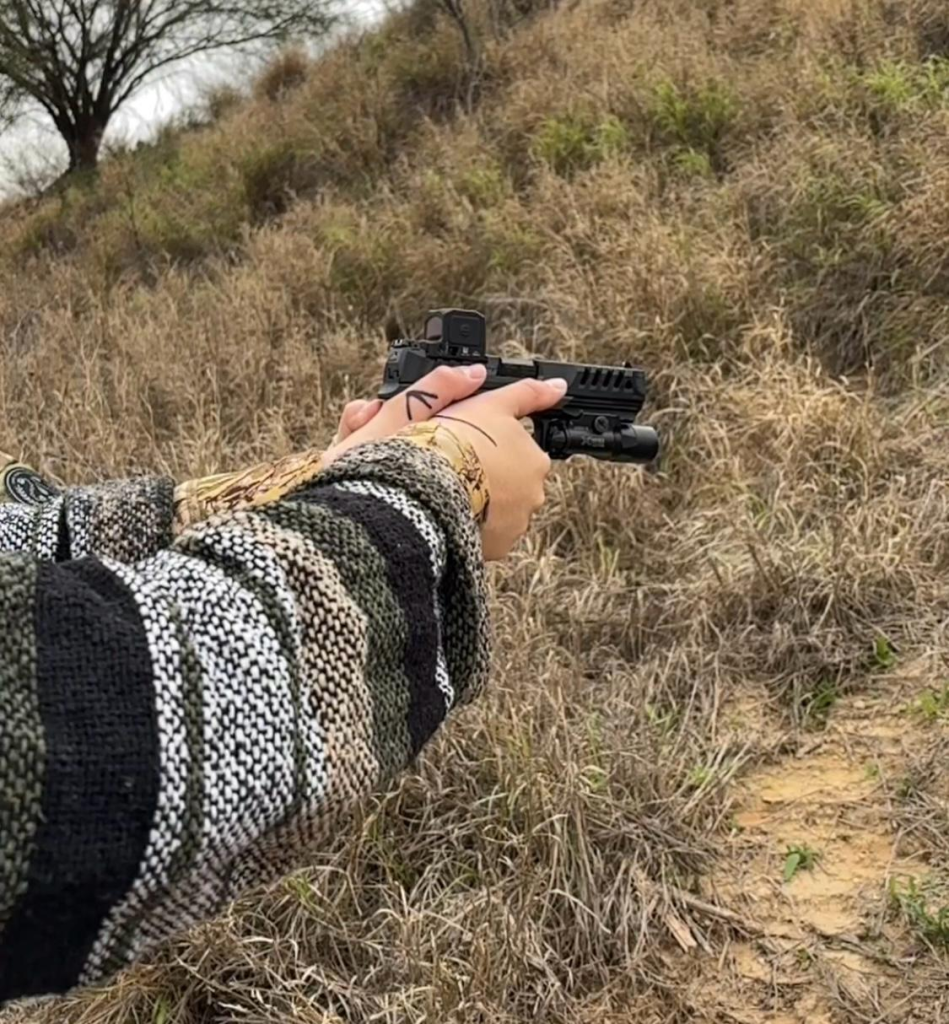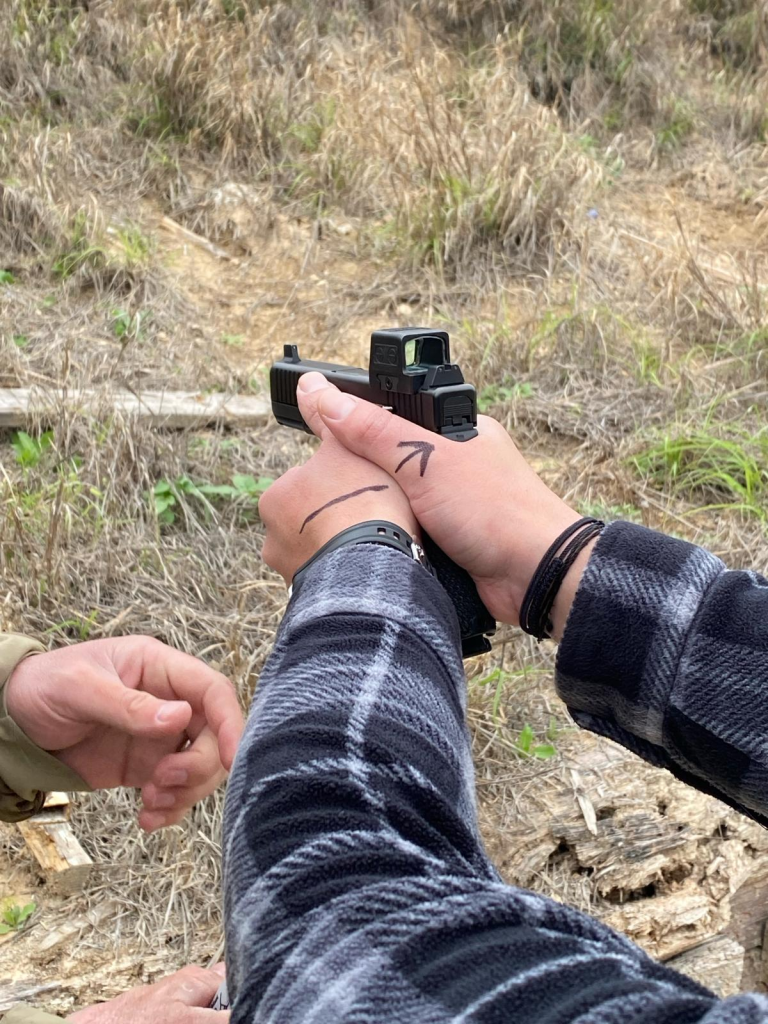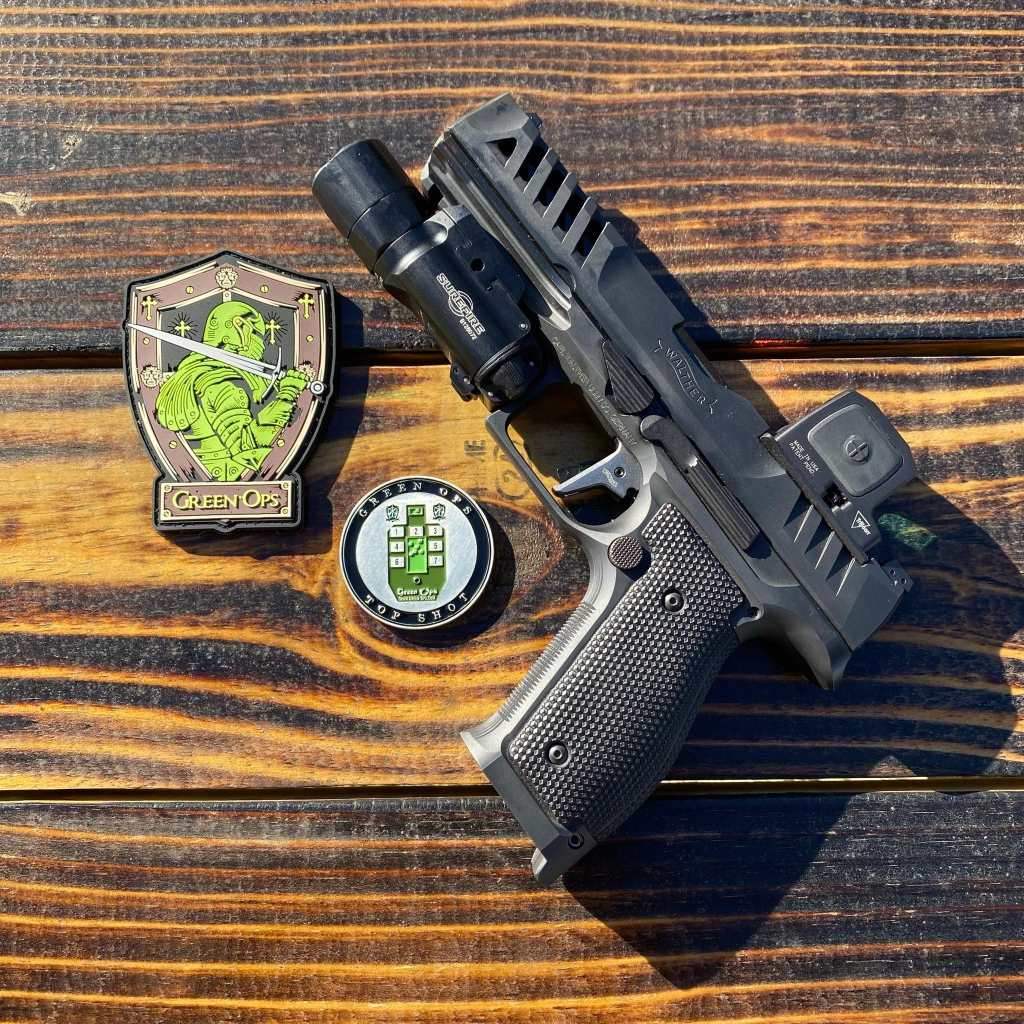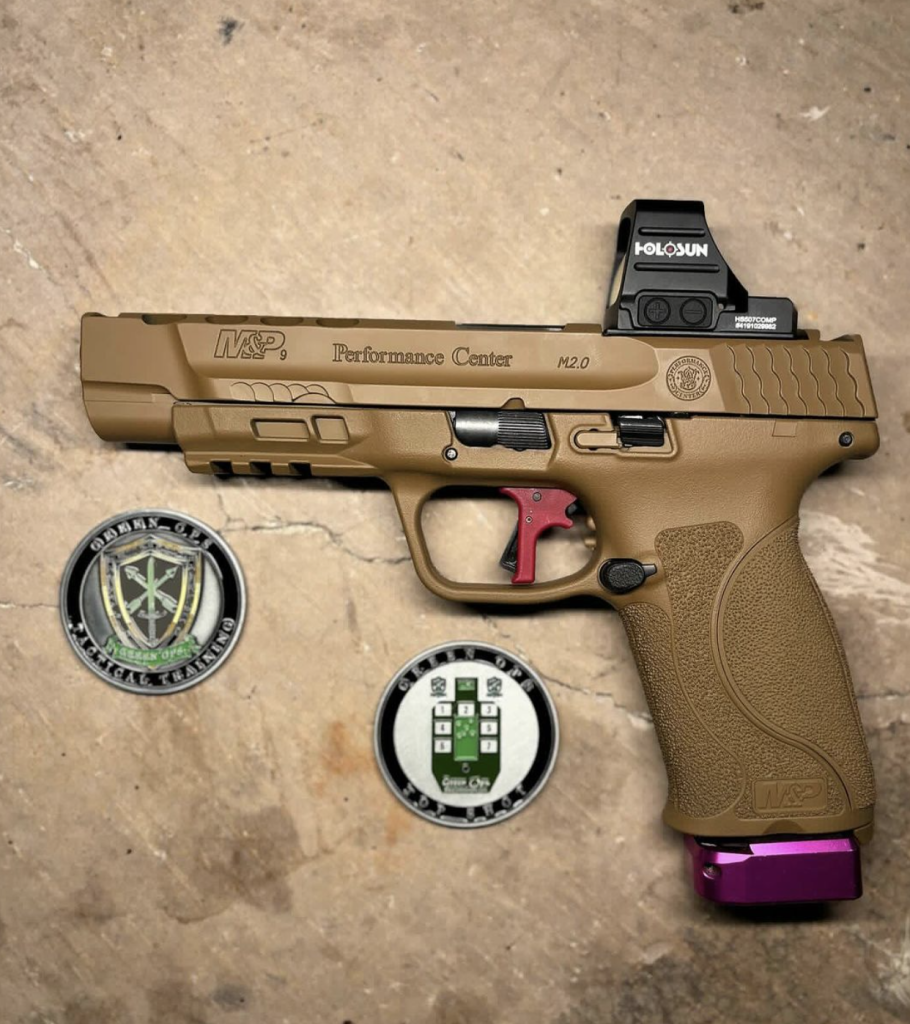On Saturday February 17, 2024 I had the privilege of driving to The Ranch in Dilley, Texas for my second training course with Green Ops, Inc.
I was very impressed with the specificity, details, skill levels, mindset and ability of the Green Ops instructors at the LPVO course I took last autumn. Since then, I made a mental note to try and show up to the next Green Ops handgun class that lined up with my schedule. I figured if their team could teach carbine stuff to students the way they do, I wanted to see what they could do about handgun shooting.
I wasn’t disappointed.
Advertisement — Continue Reading Below
Green Ops AAPM Course Overview

Perhaps because of the cold and windy weather, only three other students besides myself showed up. Those who didn’t make it sadly missed out. I think the remaining four of us got lucky because our class essentially became a semi-private lesson. This relaxed atmosphere is more conducive to learning and performance.
Matt McGuire, the Director Of Training in Texas for Green Ops, led the course as the main instructor. McGuire is endorsed by MSP/Scott Jedlinski and many of his methodologies stem from the “Jedi shooting school of thought.” He had no problem throwing down and demonstrating skills and concepts to a high level. For example, there were several times when McGuire made sub-second draws look boring and normal. Most importantly, McGuire’s skill as an instructor shone through in the way he taught and presented information. Green Ops assistant instructors Jaq and Jason were there to back up Mr. McGuire. They both kept a watchful eye over students while stepping to offer guidance when needed. In fact, I’m indebted to Jaq for taking some time to help me work on my AIWB draw.
Advertisement — Continue Reading Below
Handgun Fundamentals
Advanced Application of Pistol Mechanics (AAPM) methodically covers handgun fundamentals in context for experienced handgun shooters. It can also be viewed as an introduction to higher performance shooting. The first portion of the coursework is spent combing over all core elements. Those elements were grip, stance, trigger control, sight alignment, drawing and presentation. Each topic gets an instructor demo and lecture, and students shoot relevant live fire as it pertains to that topic.
During live fire, instructors keep an eye on students and dispensing guidance as needed. The second portion of the class delved into skills and drills. These exercises were a good mix of rapid fire scenarios like Bill Drills or the 3-2. Time was also spent on precise slow fire at 25-yards on full size NRA B6 targets. Also at 40-60 yards on IPSC sized steel targets. There was also brief segment covering shot-calling that was short, sweet and to the point.
After these slow and rapid fire drills were finished, the instructors walked the students through the very challenging Green Ops handgun standards (see below). We ran through the Green Ops standards twice as the course’s culminating exercise and winded things down by means of friendly informal competition. None of us students cleared the standards, and frankly they keep even the instructors honest. The end-match consisted of students lining up head to head-to-head and seeing who could nail either ISPC sized steel target 40 yards away the quickest.
Advertisement — Continue Reading Below
Personal Highlights
McGuire demonstrated a (new-to-me) gripping method for the support hand. It relies on only applying tension with the wrist and fingers, and wrapping up the support hand around the gun. The premise of this is to keep the gun steady using the strength of the support hand, while leaving the firing hand relatively relaxed and free. If the firing hand is too tense, it becomes near impossible to get lightning quick splits and the chances of incurring trigger freeze increase dramatically. I know, because I often deal with it.
The most surprising element of this alternative grip is the fact that the thumbs hardly play a role during firing. As I write this two days after the class, I’m still digesting this and dry-firing in this manner. Mr. McGuire drew a line across both of my hands as a visual reminder of where my hands needed to be placed. A great way to get the most out of this firing grip. In fact, everyone got lines drawn across their hands.

Advertisement — Continue Reading Below

Do The Wave
The coverage of Jedi’s “wave” technique is also worth mentioning too. I’ve seen it on Youtube, but have never had an experienced coach demonstrate it in person or walk me through it. The wave’s premise is that by presenting the gun with an upward arc, the path stops with the dots or sight on the target. In other words, it’s easier to miss the dot when the gun is swinging upward rather than coming down from above. All Green Ops instructors demonstrated quick draws with an aggressive downward stabbing scooping motion, then brought the gun to chest level where they’d apply the wave and finish presenting the pistol to the target. As with all things related to shooting, there’s no such thing as “a way” but there are many ways to do many things, and it behooves the well-rounded shooter to be aware of the more useful ones.
Advertisement — Continue Reading Below
With regards to the distance shooting portion of the class, I liked that we shot at full-size targets and not just the repair center. That provided better diagnostics for everyone, especially for a tricky subject like precision pistol distance shots.
Guns And Gear
AAPM is gun and gear agnostic, so as long as the pistol is reliable, you should be okay. Regardless, one should bring ample magazines for their chosen pistol. At least four for those with 15+ rounds and maybe more for lower capacity mags. Most holster and rig configurations are welcome, with the exception of the SERPA holster because of the liability it represents. I shot from concealment using my PHLster Floodlight 2 while others shot from their duty set ups (e.g. Safariland buckets). I don’t get the impression that bringing a competition rig to Green Ops AAPM would be problematic.
Fair warning from firsthand experience this weekend: cold weather means more layers, which means a harder time to cleanly access a concealed pistol. For some of the shooting assessments done for time and score, I shed some layers in order to guarantee a cleaner draw. Likewise, with more layers it becomes more challenging to “look” the gun into the holster during re-holstering which is critical for safety.
Advertisement — Continue Reading Below

Lead Downrange
I put nearly 450 rounds through my Walther PDP Match Steel Frame at AAPM. This class also my first training course with this handgun. It was also my maiden voyage with the recently mounted Trijicon RCR. I’m happy to report that the RCR’s capstan screws didn’t budge. It was something I had been leery about due to its novel mounting system. On the flip side, the RCR’s smaller window took some getting used to, something that’s easily resolved through repetition. It has a 3.25 MOA dot, and even with my slight astigmatism, I can recognize it as being round and crisp. After covering trigger prep in class as a key element of pistol shooting, I walked away with a newfound appreciation of this Walther’s flat faced Dynamic Performance Trigger. Of course I liked the trigger before, but its flat-face is conducive to great trigger prep.
I’ve been mostly shooting the polymer and steel framed Walther PDPs during second half of 2023, but the Smith & Wesson M&P 2.0 9mm is the other striker-gun on my radar lately. The M&P 2.0s aren’t exactly new, but I think they are real sleepers in the shooting performance department. Lo and behold, both McGuire and Jaq were shooting full-size Performance Center M&P 2.0s with dots and aftermarket Apex Triggers. I think that’s a clue. The rest of the guns on the line included Jason’s dotted and comped FN 509, and other students’ Glock 19, Glock 45 and Sig Sauer M17.
Advertisement — Continue Reading Below

The Takeaway
I was humbled at this class. Since I write about shooting topics, I shoot frequently enough and my skills are on the upward swing in general. However, AAPM was reminder that there’s still a ton of information, techniques and knowledge that I don’t yet know. In fact my immediate literal ‘takeaway’ from Green Ops AAPM was how I needed to get home and incorporate some of this new material into my dry-fire regimen at once.
The AAPM is a handgun fundamentals class that’s best suited to handgun shooters with a reasonable amount of experience. This doesn’t mean that one needs to be a USPSA GM to get the most out of this class. The student who will benefit the most from this class already has an understanding of the basics of handgun shooting. Including drawing from their holster and the basics of grip, stance, sight picture, etc. As AAPM introduces more performance shooting elements, it should not be someone’s “first” pistol class because the real value of this one-day course comes from the nuances and evidence based experiences shared from the instructors.
Advertisement — Continue Reading Below
Green Ops AAPM is also a convenient course because it’s formatted as a single day event. This makes it easier both on one’s calendar and wallet. Also, I didn’t walk away with the perception that anything critical was missing from the curriculum. This course would also be useful for experienced shooters who haven’t had the chance to train for some time with the added benefit of in-person coaching. It would be an excellent way to knock that rust out.





*The Green Ops Pistol Standards
These handgun shooting standards aren’t easy but they’re also not physically impossible. You don’t need a $10,000 racegun to clean them.
1: 7 yds, 3 shots-slide lock reload-3 shots, par time 4.0s
(took me over seven seconds by having a slow reload).
2: 7 yds, 2 shots SHO, 2 shots WHO, par time 4.0s
(took me over six seconds by being overly careful)
3: 7 yds, 1 shot in head box A zone, par time 1.5s
(best I could do was 2.04 seconds, need to work on my draw)
4: 25 yds Bill Drill, 6 shots @ A-Zone, par time 6.0s
(this is the only thing I can clear, with my best run being 4.9 seconds clean)
**Special Thanks to Jaq for allowing me to use his photos here.















